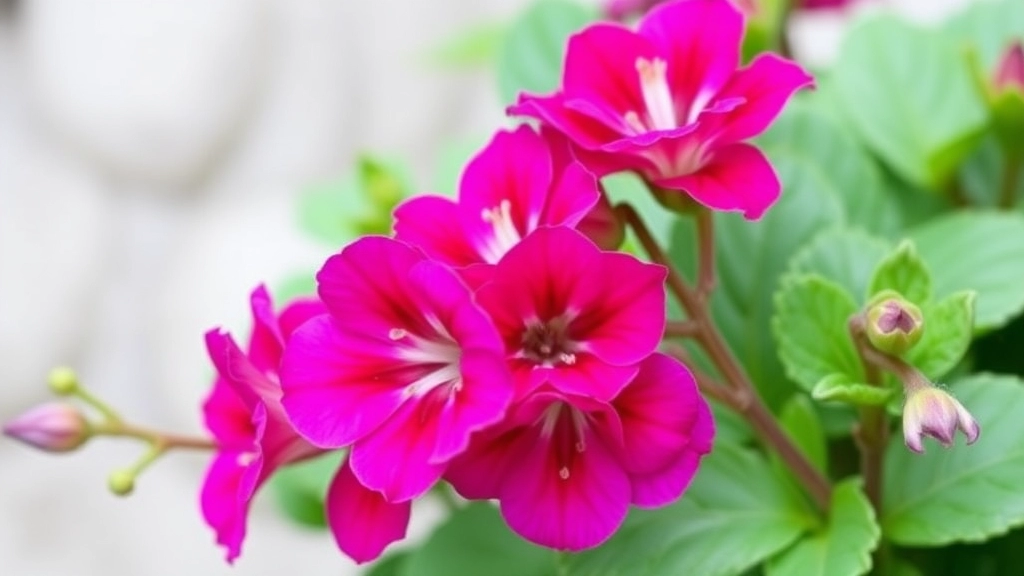Florist Kalanchoe Purple: A Vibrant Addition to Your Garden
If you’re looking to add a splash of vibrant colour to your indoor or outdoor garden, the Florist Kalanchoe Purple is a fantastic choice. This eye-catching succulent, known for its stunning purple hues, is not only beautiful but also relatively easy to care for. Whether you’re a seasoned gardener or a beginner, understanding the unique characteristics and care requirements of this plant can help you maintain its health and vibrant appearance.
Versatility of the Florist Kalanchoe Purple
One of the best aspects of the Florist Kalanchoe Purple is its versatility. From selecting the right variety to mastering its light, soil, and watering needs, there’s a lot to explore. In this guide, we’ll delve into everything you need to know, from optimal growing conditions to troubleshooting common issues, ensuring your Kalanchoe thrives and adds a touch of elegance to your space.
Best Kalanchoe Varieties Featuring Purple Hues
When it comes to adding vibrant colour to your home, purple Kalanchoe varieties are a fantastic choice.
These stunning succulents not only brighten up your space but also bring a touch of elegance.
1. Kalanchoe Blossfeldiana
- Description: This popular variety boasts clusters of small, vibrant purple flowers.
- Growth Habit: Compact and bushy, perfect for small spaces.
- Care Tip: Regular deadheading encourages more blooms. For more details, check out our indoor vs outdoor care guide.
2. Kalanchoe ‘Purple Butterflies’
- Description: Known for its unique, butterfly-shaped leaves with a striking purple tint.
- Growth Habit: Grows upright and can reach up to 30 cm in height.
- Care Tip: Thrives in bright light; keep it well-drained. Learn more in our complete guide.
3. Kalanchoe ‘Fang’
- Description: Features serrated leaves with a lovely purple edge.
- Growth Habit: An eye-catching succulent that adds texture to any collection.
- Care Tip: Water sparingly to prevent root rot.
4. Kalanchoe ‘Calandiva’
- Description: This variety showcases stunning double flowers in shades of purple.
- Growth Habit: Compact, making it ideal for pots and window sills.
- Care Tip: Needs moderate watering; allow soil to dry between sessions.
5. Kalanchoe ‘Pink Butterflies’
- Description: Displays a mix of purple and pink hues, creating a soft, romantic look.
- Growth Habit: Spreads out nicely, making it great for hanging baskets.
- Care Tip: Prefers indirect sunlight to maintain its colour.
How to Care for Purple Florist Kalanchoe
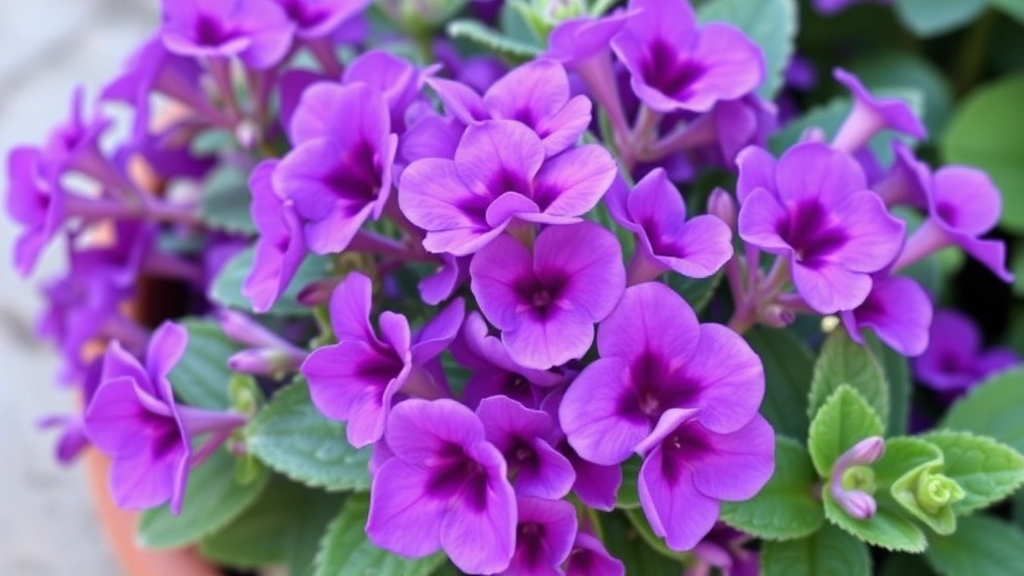
So, you’ve got your hands on a stunning Purple Florist Kalanchoe—now what?
Caring for these beauties is pretty straightforward, but there are a few things to keep in mind to keep them blooming and thriving.
Watering
- Drench and Dry: Water your Kalanchoe thoroughly, then let the soil dry out completely before the next watering.
- Frequency: Typically, every 2-3 weeks is good, but adjust based on your home’s humidity.
Light
- Bright, Indirect Light: These plants love bright light but can be sensitive to harsh direct sun. A spot near a window with filtered light is ideal.
- Signs of Too Much Sun: If the leaves start to look scorched or faded, it might be getting too much sun.
Temperature and Humidity
- Ideal Range: Keep your Kalanchoe in a warm spot—between 18°C to 24°C (65°F to 75°F) is perfect.
- Avoid Drafts: Keep it away from chilly drafts or sudden temperature changes.
Fertilizing
- Light Feeding: Use a diluted, balanced fertilizer every month during the growing season (spring and summer).
- Skip Winter: No need to fertilize in the winter when the plant is resting.
Pests and Diseases
- Watch for Trouble: Keep an eye out for common pests like aphids and mealybugs.
- Quick Action: If you see any, treat them with insecticidal soap or neem oil.
Light Requirements for Optimal Growth
When nurturing your purple Kalanchoe, you might find yourself asking: How much light does my plant really need?
Kalanchoe thrives in bright, indirect sunlight, making it essential to place your plant in the right spot for optimal growth. Here’s what you need to know:
- Bright, Indirect Light: Aim for around 6 hours of bright, indirect sunlight each day. A south-facing window is often ideal.
- Avoid Direct Sunlight: While Kalanchoe loves light, too much direct sunlight can scorch the leaves. If you notice any browning or wilting, it might be time to move your plant to a shadier spot.
- Artificial Lighting: If natural light is limited, consider using grow lights. These can supplement your plant’s light needs, especially during the darker months.
- Seasonal Changes: Be mindful of the seasons; as days get shorter in winter, you may need to adjust the light exposure.
Finding the perfect light balance is crucial for the vibrant blooms and overall health of your Kalanchoe. For more detailed care tips, check out our Kalanchoe plant lifespan care tips and learn about the care tips for flowering Kalanchoe.
IV. Soil and Watering Needs for Succulent Health
When it comes to keeping your purple Kalanchoe thriving, understanding its soil and watering requirements is crucial. Many gardeners often wonder, “What type of soil is best for my Kalanchoe?” and “How often should I water it?” Let’s delve into these essential aspects.
Soil Requirements
Kalanchoe plants flourish in well-draining soil. Here’s what you need to know:
- Cactus Mix: A pre-made cactus or succulent mix is ideal. It provides the drainage Kalanchoe loves.
- DIY Mix: You can also create your own by combining:
- 50% potting soil
- 25% perlite
- 25% sand
This combination ensures that moisture doesn’t linger, preventing root rot.
Watering Needs
Watering is where many enthusiasts stumble. Overwatering is a common mistake. Here’s a straightforward guide:
- Frequency: Water your Kalanchoe every 2-3 weeks, allowing the soil to dry out completely between waterings.
- Seasonal Adjustments: In winter, reduce watering to once a month as the plant enters dormancy.
- Signs of Thirst: Look for wrinkled leaves; this indicates your plant needs water.
Tips for Watering
- Use Room Temperature Water: Cold water can shock the roots.
- Water at the Base: Avoid wetting the leaves to prevent rot and fungal issues.
By following these soil and watering guidelines, your purple Kalanchoe will remain healthy and vibrant.
Pruning and Encouraging Reblooming
Have you ever wondered how to keep your purple Kalanchoe blooming beautifully?
Pruning is essential for maintaining the health and vibrancy of your plant.
Here are some straightforward tips to help you prune effectively and encourage your Kalanchoe to rebloom:
- Timing is Key: The best time to prune your Kalanchoe is after the flowering period, typically in late spring or early summer. This allows the plant to focus its energy on new growth.
- Remove Dead Flowers: Gently pinch or cut off spent blooms at their base. This process, known as deadheading, encourages the plant to produce new flowers.
- Trim Leggy Growth: If you notice any long, leggy stems, it’s time to trim them back. Cut just above a leaf node to promote bushier growth.
- Shape the Plant: Regularly shaping your Kalanchoe will help maintain a compact and attractive appearance. Aim to remove about one-third of the plant if it has become too bushy.
- Use Clean Tools: Always use clean, sharp scissors or pruning shears to avoid introducing diseases.
Encouraging reblooming also involves a few additional steps:
- Adjust Light Exposure: After pruning, ensure your Kalanchoe receives adequate light. This is crucial for new growth and flowering.
- Fertilise Wisely: Use a balanced fertiliser every few weeks during the growing season to provide the nutrients your plant needs.
- Monitor Watering: Avoid overwatering, as this can lead to root rot. Let the soil dry out between waterings.
For more detailed information on maintaining your Kalanchoe, check out our best tips and techniques for pruning Kalanchoe plants or explore our guide to growing and reblooming florist Kalanchoe indoors.
Common Issues: Troubleshooting Purple Kalanchoe
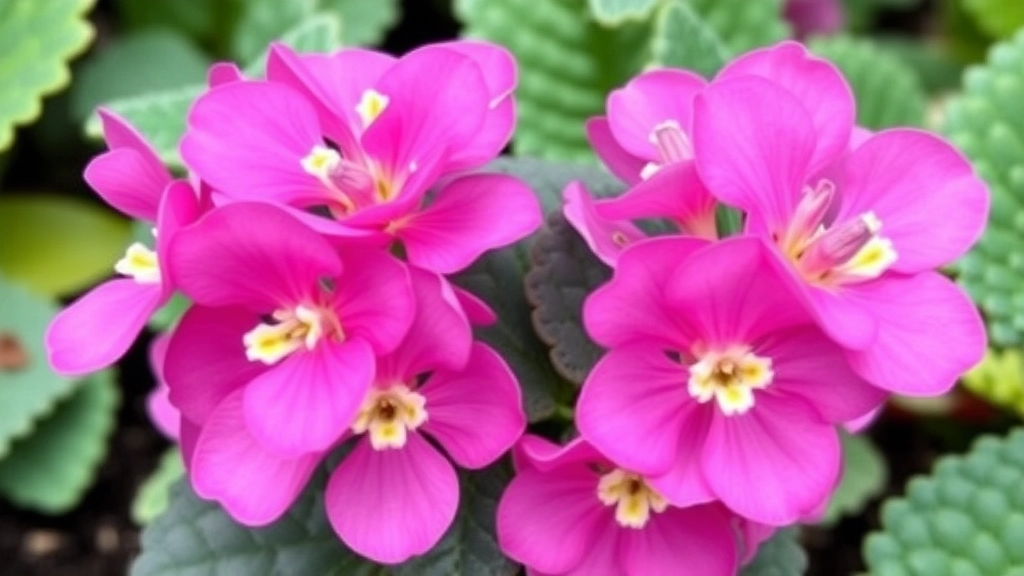
So, you’ve got your stunning purple Kalanchoe, but something doesn’t seem quite right? You’re not alone! Many of us face a few hiccups when growing these beauties. Let’s dive into some common issues and how to tackle them.
1. Drooping Leaves
Why it happens: Overwatering is usually the culprit.
What to do:
- Check the soil—if it’s soggy, hold off on watering.
- Let it dry out completely before you give it another drink.
2. Yellowing Leaves
Why it happens: This could be due to too much water or lack of nutrients.
What to do:
- Ensure you’re not drowning your plant.
- Consider using a balanced fertiliser every few weeks during the growing season.
3. Leggy Growth
Why it happens: Insufficient light can cause Kalanchoe to stretch towards the light.
What to do:
- Move your plant to a brighter spot.
- Rotate it occasionally to promote even growth.
4. Pests
Why it happens: Like any plant, Kalanchoe can attract pests like aphids or mealybugs.
What to do:
- Inspect your plant regularly.
- Use insecticidal soap or a neem oil solution to keep those pesky critters at bay.
5. Poor Flowering
Why it happens: This could stem from inadequate light or improper watering.
What to do:
- Make sure it’s getting enough sunlight.
- Adjust your watering schedule—Kalanchoe prefers to be on the dry side.
6. Fungal Issues
Why it happens: High humidity and poor air circulation can lead to fungal problems.
What to do:
- Ensure your plant has good airflow.
- If you spot any fungal growth, remove affected areas and consider using a fungicide.
Propagating Kalanchoe: Stem Cuttings and Offsets
If you’ve ever wondered how to expand your collection of beautiful purple Kalanchoe, you’re not alone. Propagation is a rewarding way to multiply your plants without breaking the bank.
Stem Cuttings
One of the most common methods for propagating Kalanchoe is through stem cuttings. Here’s how you can do it:
- Select a Healthy Stem: Choose a stem that is healthy and free from any disease. Look for one that has at least two to three leaves.
- Make the Cut: Using clean, sharp scissors or pruning shears, cut a section of the stem about 4 to 6 inches long. Make the cut just below a leaf node for optimal growth.
- Allow to Callus: Place the cutting in a dry location for a few hours to allow the cut end to callus over. This helps prevent rot when planted.
- Plant the Cutting: Fill a small pot with well-draining soil. Insert the callused end of the cutting into the soil, burying it about an inch deep.
- Water Sparingly: Lightly water the soil, but avoid soaking it. Keep the soil slightly moist but not wet.
- Provide the Right Environment: Place the pot in a warm, bright location but out of direct sunlight.
- Patience is Key: Roots should develop in a few weeks. You can gently tug on the cutting to check for resistance, indicating root growth.
Offsets
Kalanchoe plants often produce offsets, or “pups,” that can be easily propagated. Here’s how:
- Identify Offsets: Look for small plants growing at the base of the parent plant.
- Gently Remove: Use your fingers or a small tool to carefully detach the offset from the main plant, ensuring you get some roots.
- Prepare for Planting: Allow the offset to callus for a few hours before planting it in well-draining soil.
- Water and Care: Treat offsets similarly to stem cuttingsâwater lightly and place in a warm, bright location.
By propagating Kalanchoe through stem cuttings and offsets, you can easily expand your collection and share the joy of these stunning plants with friends and family. For more detailed guidance, you might find our guide on propagating Kalanchoe Mother of Thousands helpful. Additionally, if you’re interested in the various types of Kalanchoe, check out our visual guide and care tips for Kalanchoe species.
Indoor vs. Outdoor Growing Tips for Kalanchoe
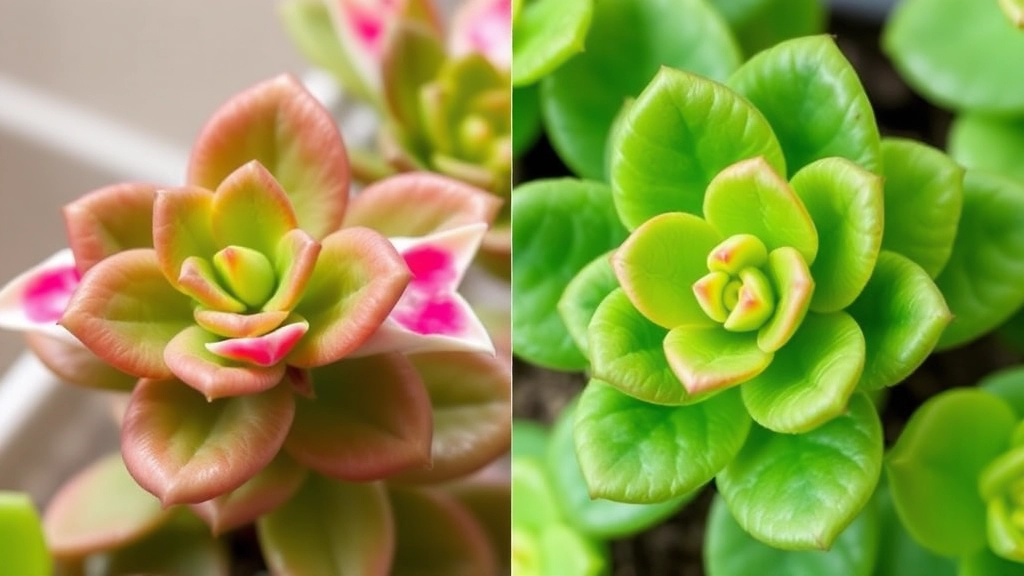
So, you’ve got your stunning purple Kalanchoe and you’re wondering where it’ll thrive best, right?
Let’s dive into the differences between indoor and outdoor growing for these beauties.
Indoor Growing Tips
- Light:
- Place your Kalanchoe near a bright window.
- They love that indirect sunlight, so avoid harsh afternoon rays.
- Temperature:
- Keep it cozy! Ideal temperatures range from 15°C to 25°C.
- Avoid cold drafts or sudden temperature changes.
- Humidity:
- Kalanchoe prefers drier air, so don’t stress about humidity levels.
- Just keep them away from overly humid areas like bathrooms.
- Watering:
- Water when the top inch of soil feels dry.
- Less is more; they’re succulents, after all!
- Fertilizing:
- Feed with a balanced succulent fertilizer during the growing season.
- Skip fertilizing in winter when they’re resting.
Outdoor Growing Tips
- Light:
- Full sun is your Kalanchoe’s best friend! Aim for at least 6 hours of sunlight daily.
- If it’s too hot, consider some afternoon shade.
- Soil:
- Use well-draining soil; cactus mix works wonders.
- Good drainage is key to avoiding root rot.
- Watering:
- Water deeply but infrequently.
- Allow the soil to dry out completely between waterings.
- Temperature:
- They’re not fans of frost. Bring them inside if temperatures drop below 10°C.
- They thrive in warm, sunny climates.
- Pests:
- Keep an eye out for pests like aphids or mealybugs.
- A gentle spray of water often does the trick.
Seasonal Flowering and Maintenance
As we transition from one season to another, it’s essential to understand how seasonal changes impact the flowering and maintenance of your purple Kalanchoe.
Seasonal Flowering Patterns
Spring and Summer
During these warmer months, your Kalanchoe will thrive, often producing vibrant blooms. Here’s how to ensure optimal flowering:
- Light Exposure: Ensure your plant receives ample sunlight, ideally 6 hours of indirect light daily.
- Watering: Increase watering frequency but avoid waterlogging. Allow the soil to dry between waterings.
Autumn and Winter
As temperatures drop, flowering may slow down. However, with proper care, you can encourage continued growth:
- Reduced Watering: Cut back on watering, as the plant enters a dormant phase.
- Temperature Control: Keep your Kalanchoe in a warm spot, ideally between 15°C to 20°C.
Maintenance Tips Throughout the Seasons
To keep your purple Kalanchoe healthy and blooming, consider the following maintenance tips:
- Fertilisation: Use a balanced fertiliser every 4-6 weeks during the growing season. This promotes vibrant blooms.
- Pruning: After flowering, prune back spent blooms and any leggy growth to encourage new growth.
Recognising Flowering Issues
If your Kalanchoe isn’t blooming as expected, consider:
- Insufficient Light: Ensure it’s getting enough indirect sunlight.
- Overwatering: This can lead to root rot, stunting growth.
For more detailed care tips, check out our guide on flowering Kalanchoe care. Additionally, if you’re curious about different species, explore our article on different Kalanchoe species.
Benefits of Purple Kalanchoe in Home Decor
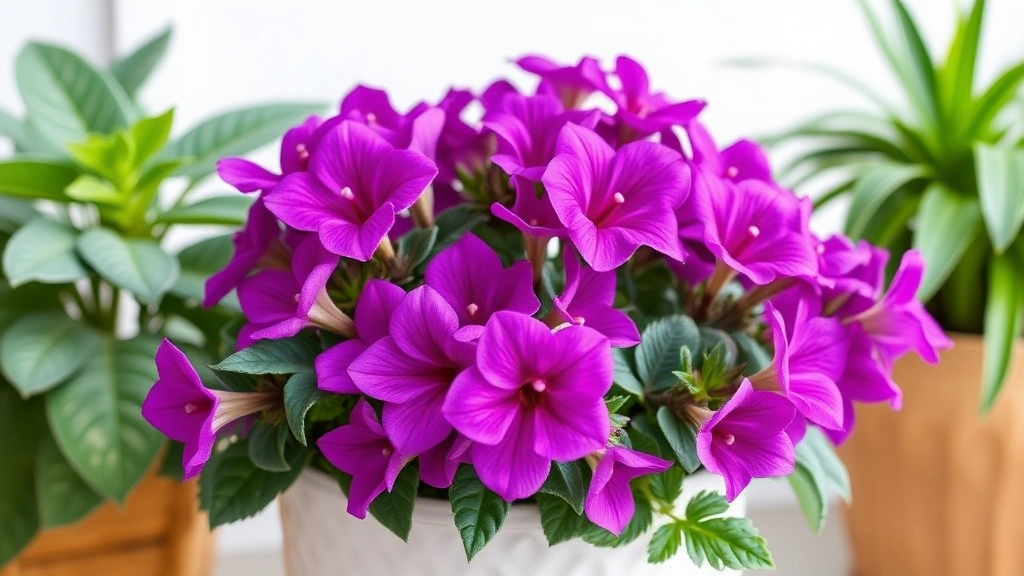
So, you’re considering adding some flair to your home, right?
Purple Kalanchoe is not just a pretty face; it offers a bunch of benefits that can really elevate your space.
Eye-Catching Aesthetics
- Vibrant Colour: The rich purple hues can brighten up any room.
- Versatile Style: Whether your decor is modern, rustic, or bohemian, these plants fit right in.
- Seasonal Appeal: They bloom beautifully, providing a pop of colour all year round.
Air Quality Improvement
- Natural Air Purifier: Kalanchoe helps to filter toxins from the air, making your home feel fresher.
- Mood Booster: The presence of greenery can enhance your mood and reduce stress.
Low Maintenance
- Easy Care: Perfect for busy lifestyles! Just a bit of sunlight and occasional watering.
- Durable: They’re hardy and can withstand a bit of neglect.
Unique Gift Idea
- Thoughtful Present: A purple Kalanchoe makes a lovely gift for friends and family.
- Symbolism: They represent prosperity and good luck, adding a meaningful touch.
Enhancing Spaces
- Table Centrepieces: They can be a stunning focal point on dining tables or coffee tables.
- Window Sills: Add them to your windows for a cheerful view from inside and outside.
When considering the best companions for your purple Kalanchoe, you may wonder which plants will enhance its beauty while thriving together.
### Ideal Companion Plants
– **Aloe Vera**
– Both are succulents, making them compatible in terms of care.
– Aloe’s tall, spiky leaves contrast beautifully with Kalanchoe’s rounded blooms.
– **Sedum**
– Low-maintenance and drought-resistant.
– Available in various colours and textures, adding visual interest.
– **Echeveria**
– Another succulent that pairs well due to similar light and watering needs.
– Their rosette shape complements Kalanchoe’s flowers.
– **Zamioculcas zamiifolia (ZZ Plant)**
– Thrives in low light, making it a great indoor companion.
– Its glossy leaves provide a striking contrast to the purple hues of Kalanchoe.
– **String of Pearls**
– A trailing succulent that adds a unique touch to your arrangement.
– Its cascading nature creates a lovely visual effect when placed above Kalanchoe.
### Benefits of Companion Planting
– **Pest Control**: Some plants naturally deter pests, protecting your Kalanchoe.
– **Aesthetic Appeal**: A mix of shapes, sizes, and colours makes your display more engaging.
– **Microclimate Creation**: Grouping plants with similar needs helps maintain humidity and temperature.
### Tips for Successful Pairing
– Ensure all plants have similar light and watering requirements.
– Use well-draining soil to prevent root rot.
– Consider the growth habits of each plant to avoid overcrowding.
For more detailed care tips, you might find our [complete care guide for Kalanchoe Beharensis Felt Plant](https://planthq.org/complete-care-guide-for-kalanchoe-beharensis-felt-plant/) useful. Additionally, if you’re interested in specific varieties, check out our [guide to the best Kalanchoe succulents for sale](https://planthq.org/kalanchoe-succulent-for-sale-best-varieties-prices/).
FAQs on Purple Florist Kalanchoe
What type of light is best for Purple Florist Kalanchoe?
Bright, indirect light is ideal for Purple Florist Kalanchoe. Place it near a window with filtered light to avoid harsh direct sunlight.
How often should I water my Purple Florist Kalanchoe?
Water your Kalanchoe thoroughly and then let the soil dry out completely before the next watering. Typically, every 2-3 weeks is sufficient, but adjust based on your home’s humidity.
What is the ideal temperature range for Purple Florist Kalanchoe?
Keep your Kalanchoe in a warm spot between 18°C to 24°C (65°F to 75°F). Avoid exposing it to chilly drafts or sudden temperature changes.
What kind of soil is best for Purple Florist Kalanchoe?
Kalanchoe plants flourish in well-draining soil. A pre-made cactus or succulent mix is ideal. You can also create your own mix by combining 50% potting soil, 25% perlite, and 25% sand.
How often should I fertilize my Purple Florist Kalanchoe?
Use a diluted, balanced fertilizer every month during the growing season (spring and summer). There’s no need to fertilize in the winter when the plant is resting.
What should I do if my Purple Florist Kalanchoe has drooping leaves?
Drooping leaves are usually a sign of overwatering. Check the soil—if it’s soggy, hold off on watering and let it dry out completely before watering again.
How can I prevent pests on my Purple Florist Kalanchoe?
Inspect your plant regularly for common pests like aphids and mealybugs. If you see any, treat them with insecticidal soap or neem oil.
What are the benefits of having Purple Florist Kalanchoe in home decor?
Purple Kalanchoe offers vibrant color, improves air quality, is low maintenance, and makes a thoughtful gift. It’s also versatile and can enhance various spaces like table centerpieces and window sills.
Can I grow Purple Florist Kalanchoe outdoors?
Yes, Purple Kalanchoe can be grown outdoors. Ensure it gets full sun for at least 6 hours daily, use well-draining soil, and water deeply but infrequently. Bring it inside if temperatures drop below 10°C.
What should I do if my Purple Florist Kalanchoe has yellowing leaves?
Yellowing leaves can be due to too much water or lack of nutrients. Ensure you’re not overwatering your plant and consider using a balanced fertilizer every few weeks during the growing season.
How can I encourage my Purple Florist Kalanchoe to flower?
Ensure it gets enough sunlight and adjust your watering schedule. Kalanchoe prefers to be on the dry side. Also, make sure it’s not exposed to high humidity and poor air circulation to avoid fungal issues.
References
-
How to Care for Kalanchoe
-
Kalanchoe Plant Profile
-
Kalanchoe: How to Grow and Care for Kalanchoe Plants
